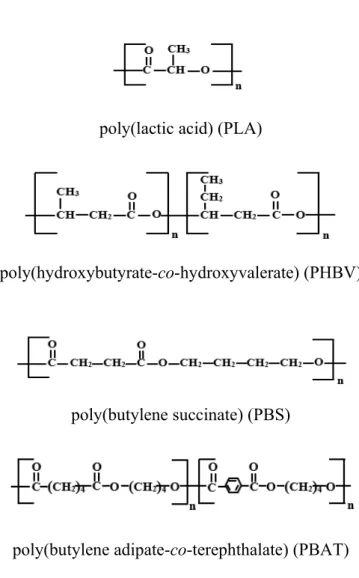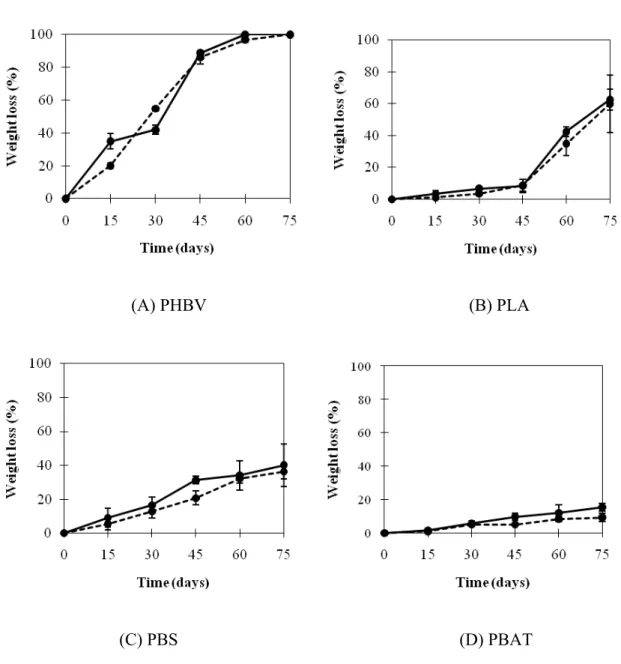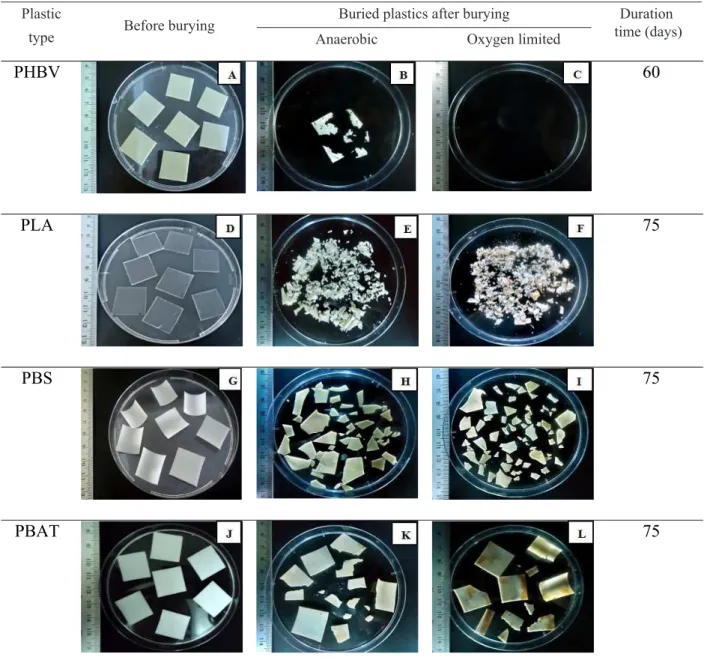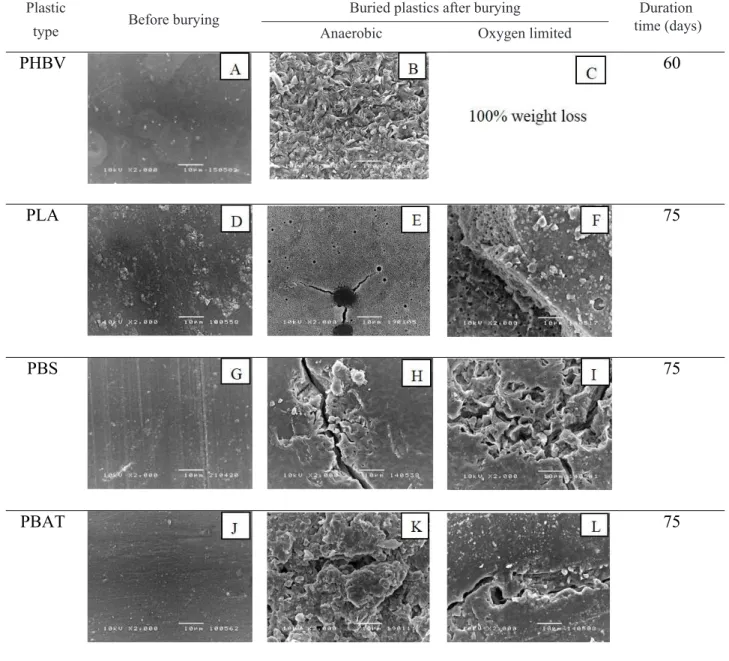Biodegradation of poly(lactic acid), poly(hydroxybutyrate-
co
-hydroxyvalerate),
poly(butylene succinate) and poly(butylene adipate-
co
-terephthalate) under anaerobic
and oxygen limited thermophilic conditions
Jutakan Boonmee a, Charnwit Kositanont b and Thanawadee Leejarkpai c
a
Inter-department of Environmental Science, Graduate School, Chulalongkorn University, Bangkok 10330, Thailand b Department of Microbiology, Faculty of Science, Chulalongkorn University, Bangkok 10330, Thailand
c
National Metal and Materials Technology Center, Pathumthani 12120, Thailand
Abstract
In order to study the biodegradation behavior of biodegradable plastics in landill conditions, four types of biodegradable plastics including poly(lactic acid) (PLA), poly(hydroxybutyrate-co-hydroxyvalerate) (PHBV), poly(butylene succinate) (PBS), and poly(butylene adipate-co-terephthalate) (PBAT) were tested by burying in sludge mixed soil medium under anaerobic and oxygen limited conditions. The experiments were operated at 52 ± 2°C in dark conditions according to ISO15985. The degree of biodegradation after 75 days was investigated by weight loss determination, visual examination, and surface appearance by scanning electronic microscopy (SEM). Under both anaerobic and oxygen limited conditions, the complete degradation (100% weight loss) was found only in PHBV after 75 days. The plastic degradations were ranked in the order of PHBV>PLA>PBS>PBAT. The percentage of weight losses were signiicantly different at p ≤ 0.05. However, for all studied plastics, the degradation under anaerobic and oxygen limited conditions did not signiicantly different at 95% conidence.
Keywords: biodegradable plastics, anaerobic conditions, burial exposure, landill
1. Introduction
Conventional plastics are petroleum based synthetic polymers that regarded as non-degradable materials. The global industrial plastic production has been continuously increased from 1.5 million tons/year in 1950 to 270 million tons/year in 2012 (Biron, 2014). Almost 50 percent of plastics produced are for single-used or disposable. Since the plastics are resistant to microbial degradation, they are very stable and not incorporated into the carbon cycle (Hayase et al., 2004). The accumulation of plastic waste in the environment, especially in soil is a global concern. Biodegradable plastics are invented as the new alternative polymers to reduce the environmental impact of conventional plastics.
Biodegradable plastics have been synthesized and introduced to the market for various applications. They can be classiied into two main groups depending on the source of raw materials. The first group is polymers that obtained from either biomass feedstock or microbial products. Aliphatic polymers especially poly(lactic acid) (PLA) and microbial produced polymers such as poly(hydroxybutyrate) (PHB) and poly(hydroxybutyrate-co-hydroxyvalerate) (PHBV) are attractive for their potential in biodegradability and wide application ranges (Gupta and Kumar, 2007; Shah et al., 2008; Sin et al., 2013; Siracusa et al., 2008; Tan et al.,
2013; Zhang et al., 2014). Another group is chemical synthesized from petroleum based resources (Bordes
et al., 2009). The biodegradable plastics from fossil
resources especially poly(butylene succinate) (PBS) and poly(butylene adipate-co-terephthalate) (PBAT) are interested for commercial scale production (Shah
et al., 2008; Abe et al., 2010; Bilck et al., 2010; Wu,
2012). They are claimed for good biodegradability and compostable (Kim and Kim, 1998; Bordes et al., 2009). The degradability of biodegradable plastic depends on environmental factors (oxygen, temperature, moisture, and pH), the properties of plastics (chemical bonds, molecular weight, and glass transition temperature (Tg)) and microorganisms (species, appropriate enzymes and levels) (Mas-Castellà et al., 1995). Landill is a common waste disposal method in Thailand. Anaerobic and oxygen limited conditions are found underground of landill sites where the large portion of waste plastic deposited. The conditions for the fast degradation of plastics under landill are still needed.
This study focuses on the degradability of two bio-based biodegradable plastics (PLA and PHBV) and two petroleum-based plastics (PBS and PBAT). The laboratory scale of soil burial test under thermophilic anaerobic and oxygen limited conditions were used in order to simulate landill conditions. In this case, sludge mixed soil was used as a burial medium as well as the source of plastic degrading microorganisms.
The international journal published by the Thai Society of Higher Education Institutes on Environment
E
nvironment
A
sia
2. Materials and Methods
2.1. Polymeric materials
Commercially available plastics, poly(lactic acid) (PLA) (NatureWork® 4043D),
poly(hydroxybutyrate-co-hydroxyvalerate) (PHBV) (Enmat® Y1000P), poly(butylene succinate) (PBS) (GS Pla, FZ91PD) and poly(butylene adipate-co-terephthalate) (PBAT) (ecolex® F Blend C1200) were obtained from National Metal and Materials Technology Center, Thailand. The chemical structures of these biodegradable plastics are showed in Fig. 1 The PLA, PBS and PBAT were molded into sheet by using cast sheet extrusion machine (HAAKE LR 8906-02F). PHBV sheets were molded by the hot press compression apparatus (LABTECH). The average thickness of all prepared sheets was 0.5 mm. The plastic sheets were cut to 2×2 cm2 as speciied in the International Standard ISO 15985 (Plastics-Determination of the ultimate anaerobic biodegradation and disintegration under high-solids anaerobic-digestion conditions).
2.2. Preparation of burial medium
The burial medium was derived from two sources. Soil was collected from Suphanburi province municipal solid waste disposal site while sludge was obtained from the anaerobic wastewater treatment plant of Malee Sampran Public Company Limited, Nakhon Pathom province, Thailand. Both materials were collected and preserved at 4°C until used. Soil and sludge were mixed at the ratio of 70:30 and used as burial medium. A 150 g of the mixture was placed into 660 mL rubber-capped glass bottles. A 1.5 g of each biodegradable plastic sample was buried in the mixture. Total solid and volatile solid of the burial medium were determined according to Standard methods (WPCF 2540B, 1995 and APHA-AWWA-WPCF 2540E, 1995). Percentages of C, H, N and C:N ratio were analyzed by CHNS/O analyzer.
poly(lactic acid) (PLA)
poly(hydroxybutyrate-co-hydroxyvalerate) (PHBV)
poly(butylene succinate) (PBS)
poly(butylene adipate-co-terephthalate) (PBAT)
109 2.3 Setting anaerobic and oxygen limited conditions
To achieve anaerobic conditions, the bottles were lush with nitrogen gas in an anaerobic glove box for 20 min and then closed with rubber-cap. In case of oxygen limited conditions, the bottles were closed with a rubber-cap to keep the natural air inside. For each type of plastic material, three bottles were prepared for weight loss determination at every 15 days for 75 days. The test bottles were incubated at 52 ± 2°C in dark condition according to ISO 15985.
2.4 Weight loss determination
The plastic samples were taken out of the speciied bottles after the test was terminated at 15, 30, 45, 60 and 75 days. They were rinsed with sterile water until free of soil particles. The cleaned and dried plastic samples were kept in a desiccator at room temperature until their weights were constant. The percentage of weight loss was calculated by using equation (1):
Weight loss (%) = [ (Wi - Wf) ] x 100
Where Wi represents the initial dry weight of plastic sheet and Wf represents the dry weight of the recovered plastic after the degradation. The percentage of weight loss was the average of three samples.
2.5 Surface morphology observation
The changes of the surface morphology of buried biodegradable plastic samples were investigated by visual examination and Scanning Electron Microscopy (SEM) (JSM-5410LV; JEOL, Tokyo, Japan).
2.6 Statistical analysis
The differences of the degradation were tested by Duncan’s multiple range tests. The effects of anaerobic and oxygen limited conditions on the biodegradation of plastic samples were tested by T-tested.
3. Results and Discussion
3.1 Properties of buried medium
In this study, the mixture of soil and sludge was used as a burial medium. The properties of soil and sludge are shown in Table 1. In this study the C:N ratio of burial medium was approximately 7:1. The initial pH of soil and sludge were 7.73 and 7.14, respectively. The pH values of soil and sludge were in the range of optimum pH for microbial growth.
3.2 Degradation of biodegradable plastic under anaerobic and oxygen limited conditions
The degradation of biodegradable plastics was measured through the percentage of weight loss. As shown in Fig. 2, the weight losses were increased according to the increased burial time of all tested materials. The percentages of weight loss are in the order of PHBV> PLA> PBS> PBAT. Under both anaerobic and oxygen limited conditions, bio-based biodegradable plastics (PLA and PHBV) showed higher percentage of weight loss than that of petroleum-based biodegradable plastics (PBS and PBAT). The complete weight loss was found only in PHBV at 60 days under the oxygen limited conditions and 75 days under anaerobic condi-tions, (Fig. 2(A)). After 75 days under anaerobic and oxygen limited conditions, PLA weight were reduced by 60.0% and 62.6%, respectively (Fig. 2(B)). For the petroleum-based biodegradable plastics, the percentage of weight loss of PBS was increased faster than that of PBAT. Fig. 2(C) showed that the percentage of weight loss of PBS after75 days under anaerobic and oxygen limited conditions were 36.2 ± 4.2% and 40.2 ± 12.6%, respectively. After 75 days, PBAT showed the lowest of biodegradation among the tested plastics. Only 9.3 ± 2.6% weight loss were shown under anaerobic and 15.6 ± 2.3% under oxygen limited conditions. Although both of them are petroleum-based biodegradable plastics, they showed quite different in the degradation behavior due to the difference in their chemical structure. It was reported that PBAT is harder to degrade than PBS under natural soil environment (Koitabashi et al., 2012). Abou-Zeid et al. (2001) reported the percentage of PHBV weight loss after 10 weeks at 37 °C degradation under anaerobic conditions using 100% methane sludge as an inoculum was 22.50%. This result showed the different percentage of PHBV weight loss from our study. It could be because the different inoculum type and incubated temperature were used. PLA degradation under anaerobic conditions was also reported. For example, Yagi et al. (2009) studied the PLA degradation using anaerobic sludge under mesophilic (35°C) and thermophilic (55°C) conditions. Their results showed that the degradation rate under thermophilic was faster than mesophilic conditions. After 60 days of degradation at 55°C, PLA was degraded about 90%. In the case of PBS, Kim et al. (2006) reported that the percentage of PBS weight loss in compost soil was higher than in the natural soil burial test and suggested as the result of higher microorganism population in compost soil. The biodegradation of PBAT that corresponding with our results was presented by Kijchavengkul et al. (2010) who studied the biodegradability of PBAT under soil degradation conditions. The result showed that soil burial conditions resulted in the slow degradation of PBAT.
Wi
110
Table 1. Physical and chemical characteristics of soil and sludge
Characteristics Soil Sludge
Total solid concentration (%) 95.70 65.40
Volatile solids (%) 9.10 51.00
%C 0.42 ± 0.04 40.57 ± 0.12
%H 0.68 ± 0.02 5.93 ± 0.11
%N 0.06 ± 0.01 5.61 ± 0.07
C:N ratio 7.48:1 7.23:1
Initial pH 7.73 7.14
(A) PHBV (B) PLA
(C) PBS (D) PBAT
b b
Figure 2. Degradation of PHBV, PLA, PBS, and PBAT under anaerobic and oxygen limited conditions
nder ( ) anae
robic and ( )
111 The statistic test of the biodegradation of the studied plastics at 75 days was shown in Table 2. The degradability of the studied plastics was signiicantly different between types of plastics. However, the anaerobic and oxygen limited conditions did not signiicantly different in the degradation percentage of the samples at 95% conidence. The result suggested that both anaerobic and oxygen limited conditions could be used for the biodegradation of biodegradable plastics such as PHBV, PLA, and PBS. However, PBAT might need longer time to biodegrade under these conditions.
3.3 Visual examination of tested biodegradable plastic
surface
The changes in the physical appearance of PLA, PBS and PBAT after burial exposure for 75 days under anaerobic and oxygen limited conditions were showed in Table 3. It was clearly seen that 100.00% weight losses were observed when PHBV sample was tested for 60 and 75 days under oxygen limited and anaerobic conditions, respectively. After 60 days, the small frag-ments of PHBV (3.0%) were found as the residue under anaerobic conditions. At the same duration, no residue of PHBV was observed under oxygen limited condi-tions (Table 3(C)). Based on visual examination, the PLA was changed from the clear color to opaque white after burial exposure. All PLA samples from anaerobic and oxygen limited conditions were disintegrated into very small friable pieces after 75 days (Table 3(E) and 3(F)). PBS sample was disintegrated into smaller and thinner pieces which make them easily broken (Table 3(H) and 3(I)). Some cracks and tears were observed on PBAT sheets after 75 days of burial exposure (Table 3(K) and 3(L)).
3.4 Surface appearance of tested biodegradable plastics
by SEM
In this work, scanning electron microscopy (SEM) was used to visualize the surface morphology during degradation process. The results of SEM at 2000X magniication of degradation surface of PHBV, PLA, PBS and PBAT were demonstrated in Table 4. Before the biodegradability test, all materials exhibited a clear and smooth surface. For PHBV, some large pores with the diameter about 300 µm were observed after 60 days of anaerobic buried time using 100X magniication of SEM (data not shown). The PHBV surfaces before and after burying for 60 days under anaerobic conditions are shown in Table 4(A) and 4(B), respectively. The ir-regular roughness was observed on the surface of PHBV residue. In the case of PLA, many small pores were ob-served on the PLA surface after 75 days of degradation as revealed in Table 4(E) and 4(F). The change in the surface morphology of PBS and PBAT when observed by SEM showed the similar proiles. Although a few cracks and holes were observed on PBAT surface, most of the surface areas were still smooth.
The results from SEM revealed the erosion on the surface of all tested biodegradable plastics. These results were in accordance with the study of Ohura
et al. (1999) who reported the erosion of PHBV surfaces
when contracted with extracellular depolymerases secreted from microorganisms in seawater. Ishikaki
et al. (2004) reported that the disappearance of the
smooth surface of PHBV ilms was observed under SEM after 80 days of burying in the aeration applying landill. Additionally, Shah et al. (2010) reported the roughness, grooves, cavities, and pit formation on the surface of PHBV ilms after 2 weeks of the cultivation with Actinomadura sp. AF-555 in the basal salt medium. Table 2. Statistical test of the biodegradation at 75 days
Biodegradable plastics biodegradation
Anaerobic conditions Oxygen limited conditions
PHBV 100.0 ± 0.0d 100.0 ± 0.0d
PLA 60.0 ± 18.0c 62.6 ± 6.8c
PBS 36.2 ± 4.2b 40.2 ± 12.6b
PBAT 9.3 ± 2.6a 15.6 ± 2.3a
The means and SD (n = 3) followed by the different letter within a column of each condition were a signiicant difference at p < 0.05.
Kim et al. (2006) reported the large holes and cracks on the PBS surfaces after burying in natural and compost soil. Kasuya et al. (2009) reported the degradation of PBAT by fungus under mild conditions. Their results supported well with our observation. It can be summarized that the erosion of the surface of test samples depends on type of plastic materials and the activity of microorganism. This summarization is supported by the reports of PHBV degrading streptomycetes and molds isolation from soil at the incubation temperature of 40°C (Mergaert et al., 1993). In accordance with this result, Phithakrotchanakoon
Table 3. Appearance of plastic samples before burying: (A) PHBV; (D) PLA; (G) PBS; and (J) PBAT, after burying under anaerobic conditions: (B) PHBV; (E) PLA; (H) PBS; and (K) PBAT, and after burying under oxygen limited conditions: (C) PHBV; (F) PLA; (I) PBS; and (L) PBAT.
Plastic
Before burying Buried plastics after burying time (days)Duration
type Anaerobic Oxygen limited
et al. (2009) reported the activities of thermophilic
Streptomyces sp. BCC23167 isolated from landill site.
Allen et al. (2011) reported the activities of soil isolated
Streptomyces sp. IN1 on PHBV degradation. Yagi et al.
(2013) reported that 100% identiication of Ureibacillus
sp. was found in thermophilic anaerobic condition (at 55°C) for PLA degradation. Abe et al., (2010) isolated PBS-degrading fungi, Fusarium solani WF-6, from the mulch sample buried in farmland. Additionally,
Leptothrix sp. TB-71 showed the high degradation
activities on Ecolex (commercial PBAT) was presented by Nakajima-Kambe et al. (2009).
PHBV 60
PLA 75
PBS 75
113 4. Conclusions
Anaerobic and oxygen limited conditions are the conditions that exist in landill conditions. According to our study, the results showed that the degree of the biodegradation of the studied plastics is nearly dependent to the studied conditions; namely anaerobic and oxygen limited conditions. However, the degree of the biodegradation was varied and depended on type of the plastic materials. The biodegradation ranks are in the order of PHBV> PLA> PBS> PBAT. Under the studied conditions, only PHBV was degraded completely (100% weight loss) after 75 days of burial exposure.
Two bio-based biodegradable plastics, PHBV and PLA, showed better degradability than petroleum-based plastics. PBAT showed the slowest degradation rate among the tested plastics under both conditions. PHBV and PLA are the appropriate biodegradable plastics to eliminate by landill disposal because they showed high degradation under thermophilic anaerobic and oxygen limited conditions. PBS has a moderate degradation rate thus it could also be eliminated by landill disposal. However, it could need a longer time to complete the degradation. PBAT are not suitable plastics for landill disposal because it showed very low and slow degradation under tested conditions.
Table 4. SEM micrographs (2,000X) of plastic surfaces before burying: (A) PHBV; (D) PLA; (G) PBS; and (J) PBAT, after burying under anaerobic conditions: (B) PHBV; (E) PLA; (H) PBS; and (K) PBAT, after burying under oxygen limited conditions: (C) PHBV; (F) PLA; (I) PBS; and (L) PBAT.
Plastic
Before burying Buried plastics after burying time (days)Duration
type Anaerobic Oxygen limited
PHBV 60
PLA 75
PBS 75
PBAT 75
Acknowledgements
This study was supported by the 90th Anniversary of Chulalongkorn University fund (Ratchadaphiseksomphot Endowment Fund).
References
Abe M, Kobayashi K, Honma N, Nakasaki K. Microbial degradation of poly(butylene succinate) by Fusarium solani in soil environments. Polymer Degradation and Stability 2010; 95: 138-143.
Abou-Zeid DM, Müller RJ, Deckwer WD. Degradation of natural and synthetic polyesters under anaerobic conditions. Journal of Biotechnology 2001; 86: 113-126. Allen AD, Anderson WA, Ayorinde F, Eribo BE. Isolation
and characterization of an extracellular thermoalkanophilic P(3HB-co-3HV) depolymerase from Streptomyces sp. IN1. International Biodeterioration and Biodegradation 2011; 65: 777-785.
APHA. Standard Methods for the examination of water and wastewater, 19th ed. APHA, AWWA, WPCF, Washington DC, USA. 1995; 2-(55-57).
Biron M. 2 - The plastics industry: economic overview. In: Thermosets and composites (Second Edition) (Eds: Biron M). William Andrew Publishing Co. Inc., Oxford, UK. 2014; 25-104.
Bilck AP, Grossmann MVE, Yamashita F. Biodegradable mulch ilms for strawberry production. Polymer Testing 2010; 29: 471-476.
Bordes P, Pollet E, Avérous L. Nano-biocomposites: Biodegradable polyester/nanoclay systems. Progress in Polymer Science 2009; 34: 125-155.
Gupta AP, Kumar V. New emerging trends in synthetic biodegradable polymers – Polylactide: A critique. European Polymer Journal 2007; 43: 4053-4074. Hayase N, Yano H, Kudoh E, Tsutsumi C, Ushio K,
Miyahara Y, Tanaka S, Nakagawa K. Isolation and characterization of poly(butylene succinate-co- butylene adipate)-degrading microorganism. Journal of Bioscience and Bioengineering 2004; 97: 131-133. Ishigaki T, Sugano W, Nakanishi A, Tateda M, Ike M,
Fujita M. The degradability of biodegradable plastics in aerobic and anaerobic waste landill model reactors. Chemosphere 2004; 54: 225-233.
Kasuya K, Ishii N, Inoue Y, Yazawa K, Tagaya T, Yotsumoto T, Kazahaya J, Nagai D. Characterization of a mesophilic aliphatic–aromatic copolyester-degrading fungus. Polymer Degradation and Stability 2009; 94: 1190-1196.
Kijchavengkul T, Auras R, Rubino M, Alvarado E, Camacho Montero JR, Rosales JM. Atmospheric and soil degradation of aliphatic–aromatic polyester ilms. Polymer Degradation and Stability 2010; 95: 99-107.
Kim HS, Kim HJ, Lee JW, Choi IG. Biodegradability of bio-lour illed biodegradable poly(butylene succinate) bio-composites in natural and compost soil. Polymer Degradation and Stability 2006; 91: 1117-1127.
Kim YD, Kim SC. Effect of chemical structure on the biodegradation of polyurethanes under composting conditions. Polymer Degradation and Stability 1998; 62: 343-352.
Koitabashi M, Noguchi, MT, Sameshima YY, Hiradate S, Suzuki K, Yoshida S, Watanabe T, Shinozaki Y, Ts u s h i m a S , K i t a m o t o H K . D e g r a d a t i o n o f biodegradable plastic mulch ilms in soil environment by phylloplane fungi isolated from gramineous plants. AMB Express 2012; 2:40.
Megaert J, Webb A, Anderson C, Wouters A, Swings J. Microbial Degradation of poly(3-hydroxybutyrate) and poly(3-hydroxybutyrate-co-3-hydroxyvalerate) in soils. Applied and environmental microbiology 1993; 59: 3233-3238.
Mas-Castellà J, Urmeneta J, Lafuente R, Navarrete A, Guerrero R. Biodegradation of Poly-β-hydroxyalkanoates in anaerobic sediments. International Biodeterioration and Biodegradation 1995; 35: 155-174.
Nakajima-Kambe T, Ichihashi F, Matsuzoe R, Kato S, Shintani N. Degradation of aliphatic–aromatic copolyesters by bacteria that can degrade aliphatic polyesters. Polymer Degradation and Stability 2009; 94: 1901–1905. Ohura T, Aoyagi Y, Takagi K, Yoshida Y, Kasuya K, Doi Y. Biodegradation of poly(3-hydroxyalkanoic acids) ibers and isolation of poly(3-hydroxybutyric acid)-degrading microorganisms under aquatic environments. Polymer Degradation and Stability 1999; 63: 23-29.
Phithakrotchanakoon C, Rudeekit Y, Tanapongpipat S, Leejakpai T, Aiba SI, Noda I, Champreda V. Microbial degradation and physico-chemical alteration of polyhydroxyalkanoates by a thermophilic Streptomyces
sp. Biologia 2009; 64(2): 246-251.
Shah AA, Hasan F, Hameed A, Ahmed S. Biological degradation of plastics: a comprehensive review. Biotechnology Advances 2008; 26: 246-265.
Shah AA, Hasan F, Hameed A. Degradation of poly (3-hydroxybutyrate-co-3-hydroxyvalerate) by a newly isolated Actinomadura sp. AF-555, from soil. International Biodeterioration & Biodegradation 2010; 64: 281-285.
Sin LT, Rahmat Abdul R, Rahman Wan AWA. 3 - Applications of poly(lactic Acid). In: Handbook of biopolymers and biodegradable plastics (Eds: Ebnesajjad S). William Andrew Publishing Co. Inc., Boston, USA. 2013; 55-69. Siracusa V, Rocculi P, Romani S, Rosa MD. Biodegradable
polymers for food packaging: a review. Trends in Food Science and Technology 2008, 19: 634-643.
Tan L, Yu X, Wan P, Yang K. Biodegradable materials for bone repairs: a review. Journal of Materials Science and Technology 2013; 29: 503-513.
Wu CS. Characterization of cellulose acetate-reinforced aliphatic–aromatic copolyester composites. Carbohydrate Polymers 2012; 87: 1249-1256.
115 Yagi H, Ninomiya F, Funabashi M, Kunioka M. Thermophilic
anaerobic biodegradation test and analysis of eubacteria involved in anaerobic biodegradation of four speciied biodegradable polyesters. Polymer Degradation and Stability 2013; 98: 1182-1187.
Zhang Z, Ortiz O, Goyal R, Kohn J. 13 - Biodegradable polymers. In: Handbook of polymer applications in medicine and medical devices, (Eds: Ebnesajjad KM). William Andrew Publishing Co. Inc., Oxford, UK. 2014; 303-335.
Received 14 June 2015
Accepted 23 November 2015
Correspondence to Ms. Jutakan Boonmee
Inter-department of Environmental Science, Graduate School, Chulalongkorn University, Bangkok 10330, Thailand
Tel: +6686 410 6215 Fax: +662 218 7668 E-mail: jutakan.b@gmail.com




